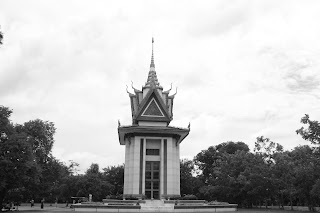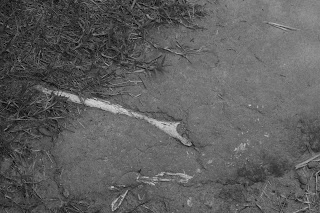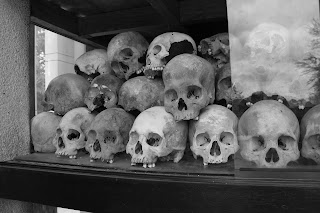Advertisement
Published: August 4th 2012
<strong id="internal-source-marker_0.6638974482193589" style="font-weight: normal;"><br class="Apple-interchange-newline" />
July 6 - I see dead people, and it’s darn depressing
<strong style="color: font-family: 'Helvetica Neue Light', HelveticaNeue-Light, 'Helvetica Neue', Helvetica, Arial, sans-serif; line-height: 19px; font-weight: normal;">
The first morning at Frangipani saw me waking up quite early. I was awake by 5.30 am and got out of bed around 6 am. This gave me time in the morning to catch up on emails, call my mom in Bangalore to check-in and say all is well and update my coordinates for the days to follow. I got ready and headed downstairs for breakfast, which was exceptionally good and filling, for a complimentary one at that. Fresh baguette slices deserve a special mention, a legacy of the French colonial occupation. After breakfast, I headed out, my camera bag in tow. The tuk-tuk driver that met me on day one was outside waiting for the anointed hour to take me to the Killing Fields. But in an ironic twist, he never did take me there, despite all his pre-scheduling and hounding me. We did start out from the hotel. It was close to 9.30 am. The trip to the Choeung Ek memorial and the Killing Fields takes a good 45 minutes one way. Given this, I could hear him faintly start grumbling that he had to be back by 1 pm at Frangipani to pick some else up for a ride. He vacillated a bit and we rode on. But on reaching the end of Rue Pasteur, past all the extremely affluent houses and widest tree lined street, he pulled over to make a phone call. He called his brother and made arrangements to transfer me to the latter’s tuk-tuk. So we waited for the brother to arrive at the place we had stopped. I passed time by reading a bit about the Pol Pot regime and watching the customer transactions in a house run laundry across the street.
The brother finally arrived. And we were on our way. The road to Choeung Ek takes one out of Phnom Penh on a dusty but metalled path. I wished I had bought the all-purpose Khmer krama (a towel/shawl-like cotton or silk piece of cloth). To access Choeung Ek memorial, we turned off the main highway and had to ride about half a kilometer. The path was lined with restaurants and some old but sturdy brick and mortar or cement houses.
The memorial has an entry ticket. The ticket includes an audio guide, which is absolutely essential to understand what went on there. The guide is narrated by one of the survivors. It is a very small place, considering scale of the atrocities committed there. The memorial stupa was built on the 10th anniversary and the skeletal remains that were previously housed in a thatched enclosure were moved to the stupa which has 17 tiers as a reminder of April 17, 1975 when Khmer Rouge began its rule. And to my dismay I discovered that this is not the only place where one can see skeletal remains of the victims.
<table class="tr-caption-container" style="padding: 4px; margin-bottom: 0.5em; margin-left: auto; margin-right: auto; text-align: center;" cellspacing="0" cellpadding="0" align="center"><tbody><tr><td>

</td></tr><tr><td class="tr-caption" style="font-size: 11px;">Choeung Ek Memorial </td></tr></tbody></table>
As mass graves go, this one is still raw. With the rainfall it receives, and ensuing erosion, new human skeletal fragments surface occasionally.
<table class="tr-caption-container" style="padding: 4px; margin-bottom: 0.5em; margin-left: auto; margin-right: auto; text-align: center;" cellspacing="0" cellpadding="0" align="center"><tbody><tr><td>

</td></tr><tr><td class="tr-caption" style="font-size: 11px;">© Vikram Krishnamurthy</td></tr></tbody></table>
There is a path that takes visitors around the various locations of import in the Killing Fields. The grave sites, erstwhile sites of temporary structures that housed the torture and killing implements are marked. And one needs to literally brace oneself when listening to the narration. The shallow graves now have grass growing. But the site still has a few trees from the 70s that were used by the Khmer Rouge in the most atrocious ways. One peepal tree had loudspeakers strung and blared patriotic music or amplified the screams of torture victims as a means to terrorize the rest. The second tree, a tamarind (if I remember it correctly) was used to smash infants’ against the trunk before throwing them into the mass grave. I still cannot fathom how one could bring oneself to do such a thing. Even if it was the fear of their own deaths, if they did not comply.
<table class="tr-caption-container" style="padding: 4px; margin-bottom: 0.5em; margin-left: auto; margin-right: auto; text-align: center;" cellspacing="0" cellpadding="0" align="center"><tbody><tr><td>

</td></tr><tr><td class="tr-caption" style="font-size: 11px;">© Vikram Krishnamurthy</td></tr></tbody></table>
I must have spent a good 3 hours walking around and listening. It was coming close to noon. And I stepped in to the museum on site for a short film about the Khmer Rouge regime and the atrocities the ensued. This film also provided a good segue to my next stop - Tuol Sleng.
A small high school building between what are now Streets 113 and 131 became a staging ground for Pol Pot's insatiable and insanely lofty goals of reshaping the make-up of the Cambodian society and the way the people lived. The class rooms became holding cells. The school yard gymnasium installations became makeshift torture devices. Hallways have rows upon rows of small and dingy prison cells slapped together hastily - some wooden and some brick and mortar. the entrance to each cell is about a foot wide and chains were reinforced into the walls or floors with mortar to shackle the occupant. The four schools buildings each 3 stories high were modified for the sole purpose of staging, cataloguing and torturing civilians before trucking them off to the Killing Fields.
<strong style="color: font-family: 'Helvetica Neue Light', HelveticaNeue-Light, 'Helvetica Neue', Helvetica, Arial, sans-serif; line-height: 19px; font-weight: normal;">
<table class="tr-caption-container" style="padding: 4px; margin-bottom: 0.5em; margin-left: auto; margin-right: auto; text-align: center;" cellspacing="0" cellpadding="0" align="center"><tbody><tr><td>

</td></tr><tr><td class="tr-caption" style="font-size: 11px;">© Vikram Krishnamurthy</td></tr></tbody></table>
A visit to these places are not to be missed at any cost. I was in two minds initially. But decided to go anyway. I am glad I did, despite the potential of subjecting myself to a depressing and sad set of events.
Advertisement
Tot: 0.076s; Tpl: 0.016s; cc: 6; qc: 43; dbt: 0.0381s; 1; m:domysql w:travelblog (10.17.0.13); sld: 1;
; mem: 1.1mb